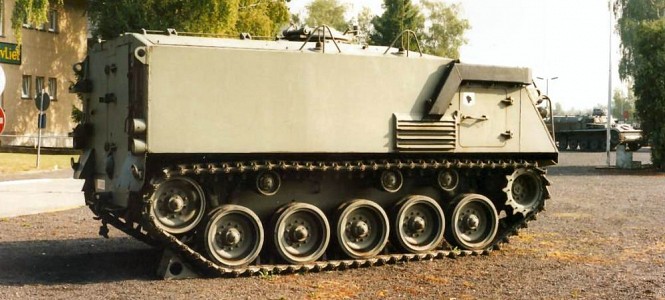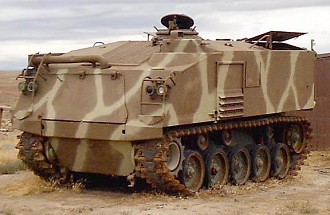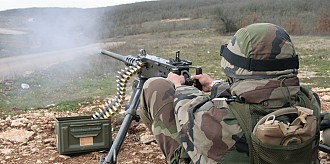Combat vehicles / Armored personnel carriers / M75
M75
General Facts
- TYPE
Armored personnel carrier - ORIGIN
 United States
United States - NICKNAMES
G260 (US military supply catalog number)
T18, T-18E1, T18E2 (prototype models) - DESIGNED
1946 - 1950 - DESIGNER
International Harvester Corporation - PRODUCTION
1951 - 1954 - PRODUCERS
 United States - FMC
United States - FMC
 United States - International Harvester Corporation
United States - International Harvester Corporation - QUANTITY
1.729 or 1.780 - UNIT COST
$ 72.000 in 1952 - CHARACTERISTICS
 Good level of protection
Good level of protection
 Very expensive to produce
Very expensive to produce
 Very heavy
Very heavy
 Limited mobility
Limited mobility
Introduction
The M75 is an early Cold War era armored personnel carrier of US origin. It was developed in the late 1940's by the International Harverster Corporation to replace the halftracks used in World War 2. The M75 was the first design in a series of US armored personnel carriers that resembles a metal box on tracks. Although the M75 functioned quite well and had a good level of protection its huge cost, high weight and limited mobility resulted in production to be halted early. As a result the M59 and later the successful M113 were developed, both vehicles share the general layout of the M75.
Layout
The M75 looks like a box on a tracked chassis, which was derived from the chassis used on the M41 light tank. The driver is seated at the front left with the engine to his right. The crew compartment is located at the rear and is accessed by two doors in the rear.
Firepower
The M75 is armed with a single 12.7mm M2HB heavy machine gun on a ring mount for which 1.800 rounds are carried.
Protection
The thick steel hull provides the crew from small arms fire and shell splinters. The level of protection is thicker than needed for stopping 7.62mm rounds, but is not fully adequate for stopping 12.7mm rounds. An NBC system and smoke grenade dischargers are both lacking.
Mobility
The tracked chassis allows the M75 to cross allmost any terrain. Due to the heavy weight the M75 is not amphibious and has a limited mobility. The average speed is low, although a top speed of 71 km/h can be achieved. The operational range is very limited due to a high fuel consumption. Propulsion is provided by a Continental 295 hp gasoline engine.
Users
The main user of the M75 was the US Army and the M75 was actively used in small numbers in the Korean war. After the war it was replaced by the lighter M59 and large numbers ended up in Belgium and a smaller batch in Ethiopia. Since the early 1980's the M75 is no longer in service.
M75
The M75 was produced only in a single variant, the armored personnel carrier. During production numerous small changes were made to reduce the production cost. These changes include the change from two rubber fuel tanks to a single metal one and the removal of some shock absorbers.
- Specifications:
- M75
| Type | Armored personnel carrier |
|---|---|
| Crew | 2 + 10 (driver, gunner, 10 infantry) |
| Length | 5.19 m |
| Width | 2.85 m |
| Height | 2.76 m (overall) |
| Ground clearance | 0.46 m |
| Weight | 18.8 t combat load |
| Ground pressure | 0.60 kg/cm2 |
| Wheelbase | Tracked chassis, 5 roadwheels, drive sprocket front, idler rear, 2.94 m length, 0.53 m width |
| Turn radius | pivot |
| Engine | Continental AO-895-4 V6 gasoline, 295 hp at 2.800 rpm |
| Power ratio | 15.7 hp/t |
|---|---|
| Transmission | Manual, 2 forward, 1 reverse |
| Speed | 71 km/h |
| Fuel | 570 L |
| Range | 185 km on road |
| Wall | 0.6 m |
| Trench | 1.7 m |
| Gradient | 60% gradient |
| Fording | 1.2 m |
| Armor | Steel, 13 to 25 mm |
| NBC equipment | No |
| Night vision | No |
|---|---|
| Smoke | No |
| Remarks | - |
| Armament | 12.7mm M2HB heavy machine gun |
| Weapon1 | 12.7mm M2HB on pintle mount on roof 1.800 rounds, 100 ready to fire manual traverse and elevation non-stabilized |
| Weapon2 | - |
| Weapon3 | - |
| Weapon4 | - |
| Weapon5 | - |
| Weapon6 | - |





